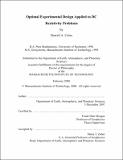Optimal experimental design applied to DC resistivity problems
Author(s)
Coles, Darrell Ardon, 1971-
DownloadFull printable version (6.253Mb)
Other Contributors
Massachusetts Institute of Technology. Dept. of Earth, Atmospheric, and Planetary Sciences.
Advisor
Frank Dale Morgan.
Terms of use
Metadata
Show full item recordAbstract
The systematic design of experiments to optimally query physical systems through manipulation of the data acquisition strategy is termed optimal experimental design (OED). This dissertation introduces the state-of-the-art in OED theory and presents a new design methodology, which is demonstrated by application to DC resistivity problems. The primary goal is to minimize inversion model errors and uncertainties, where the inversion is approached via nonlinear least squares with L1 smoothness constraints. An equally important goal is to find ways to expedite experimental design to make it practical for a wider variety of surveying situations than is currently possible.A fast, sequential ED strategy is introduced that designs surveys accumulatively by an efficient method that maximizes the determinant of the Jacobian matrix. An analysis of electrode geometries for multielectrode data acquisition systems reveals that experiment-space can be usefully decimated by using special subsets of observations, reducing design CPU times. Several techniques for decimating model-space are also considered that reduce design times.A law of diminishing returns is observed; compact, information-dense designed surveys produce smaller model errors than comparably sized random and standard surveys, but as the number of observations increases the utility of designing surveys diminishes. Hence, the prime advantage of OED is its ability to generate small, high-quality surveys whose data are superior for inversion.Designed experiments are examined in a Monte Carlo framework, compared with standard and random experiments on 1D, 2D and borehole DC resistivity problems in both noiseless and noisy data scenarios and for homogeneous and heterogeneous earth models. Adaptive methods are also investigated, where surveys are specifically tailored to a heterogeneous target in real time or in a two-stage process. (cont) The main contributions this thesis makes to geophysical inverse theory are: 1) a fast method of OED that minimizes a measure of total parameter uncertainty; 2) novel techniques of experiment-space and model-space decimation that expedite design times; 3) new methods of adaptive OED that tailor surveys to specific targets; and 4) though the OED method is demonstrated on geoelectrical problems, it can be applied to any inverse problem where the user controls data acquisition.
Description
Thesis (Ph. D.)--Massachusetts Institute of Technology, Dept. of Earth, Atmospheric, and Planetary Sciences, 2008. This electronic version was submitted by the student author. The certified thesis is available in the Institute Archives and Special Collections. Includes bibliographical references (p. 317-323).
Date issued
2008Department
Massachusetts Institute of Technology. Department of Earth, Atmospheric, and Planetary SciencesPublisher
Massachusetts Institute of Technology
Keywords
Earth, Atmospheric, and Planetary Sciences.